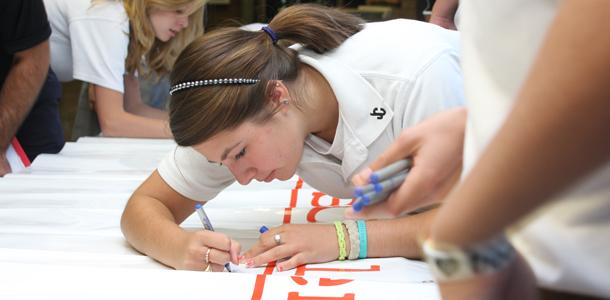On Sept. 10, junior Erica Bodt attended the first meeting of JC’s Friend’s of Rachel Club. This first meeting was also the last.
Following the Sept. 10 school-wide Rachel’s Challenge presentation, presenter Ken Scheible met with members of the SAC, NHS, and Athletic Leadership Team in the Brown Room to welcome them into the Friends of Rachel Club (FOR).
According to the Rachel’s Challenge organization, the school-wide multi-media assembly is “designed to inspire the audience to make a few simple changes in the way they look at their world and interact with it.” The FOR Club training session differs because it focuses on educating school leaders, teaching “them how to take what they heard in the assembly and make it a practical reality in their school.”
Scheible’s FOR Club training session included ideas for activities and promotional campaigns “to continue the chain reaction of kindness and compassion in the school and community” and “to help create a permanent cultural change in the school,” which are the club’s main goals according to the Rachel’s Challenge organization.
“[The FOR Club] presentation was really great. I thought that everyone was involved, and the whole idea of making a group seemed really exciting,” Bodt said.
Since the initial training presentation, the Friends of Rachel club has held no meetings and sponsored no activities or promotional campaigns.
“We thought it was a really good idea in the presentation, but we never really went with it. No one really talked about it or actually stood up and took leadership and organized anything,” Bodt said.
The Guidance Department planned the Rachel’s Challenge assembly and the FOR training presentation, which paralleled themes from the school-wide summer reading novel “Hate List.”
“[The club’s organization] was up to SAC, NHS, and the Athletic Leadership group. I thought that they were going to pull together a couple of activities and really act together as the three groups. I was really hoping that that would happen, but I haven’t heard anything.” Director of Guidance Carol Heflin-Shupe said.
“[The purpose of the FOR club] was something that we were already doing. We already do a lot of service around here,” Science Department Chair and NHS moderator Rebecca Jansing-Kaestner said.
“I think that everybody just probably got caught up in the beginning of the school year and everything was so busy. There were so many different groups involved that no one took it upon themselves [to start the club],” Assistant Athletic Director and head of the Athletic Leadership Team Stephanie Maychack said.
“I felt a little like [organizing the club] was our responsibility because we attended the meeting with student leadership, but I think that so much is just going on right now,” senior class president Tyler Boyd said.
According to Rachel’s Challenge Marketing Director for Maryland Stacey Peacock, the FOR Club training session is a $400 upgrade to the organization’s $2500 assembly-only package.
The organization says the one-hour training session “is key in sustaining the message of kindness and compassion, and affecting true, genuine change in your school.”
“The club is what really keeps the message going. It’s a constant reminder. The message comes to life in the school. Friends of Rachel clubs take on a different personality at each school,” Peacock said.
Rachel’s Challenge offers support for starting and continuing FOR Clubs beyond the basic instructional training presentation with a $995 upgrade for the organization’s Friends of Rachel Program Package. This package includes continued coaching from the organization, communication with FOR Clubs around the world, 35 weeks of meeting outlines, and supplementary promotional materials.
JC did not purchase the program support package.
“It is an additional fee just because it is expensive to have a coach linked to the school. We also give webinars and conference calls and you can get a sister school….Those materials are really important for the long term impact,” Peacock said.
“Some of the activities we have already done or could do within NHS, but we need leadership to take hold of it. That’s the problem. This type of activity students need to take hold of it,” Jansing-Kaestner said.
Jansing-Kaestner sees the FOR Club as possibly becoming an integrated part of a current organization instead of a separate club.
“One of the problems is that we do so much. Each group does so many things, and to ask them to do one more thing, it’s like where do they work it into their schedule? That’s hard,” Heflin-Shupe said.
‘It’s a very big task to organize something that affects the whole school, and it does involve so many different groups… So I don’t think that it’s an easy thing to do or an easy thing to organize,” Maychack said
Boyd believes there is “probably not” going to be a FOR Club in the future.
“I think the [Rachel’s Challenge] poster that everyone signed is as far as it’s going to get,” Boyd said. “The message is definitely still here, and I think that if they put on a guidance presentation or an assembly every year, it would still get the word across.”
“Whether we have a club or don’t have a club, the sustained awareness of how we treat each other would really be the idea that we’re aware of the way we act and what we say and how that affects other people,” Heflin-Shupe said.
Joey Hoff can be reached for comment at jhoff@jcpatriot.com.



